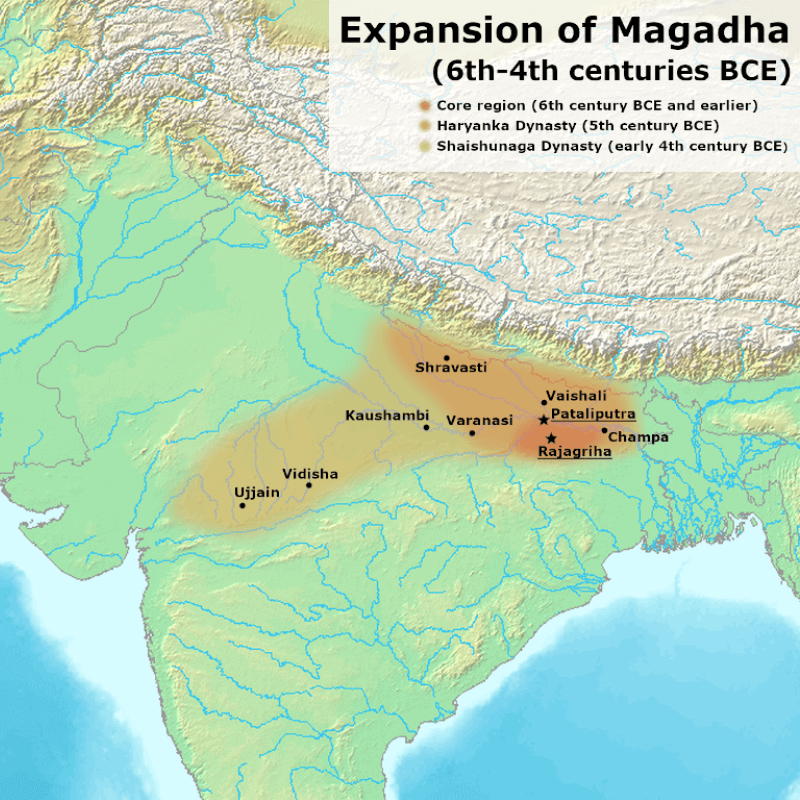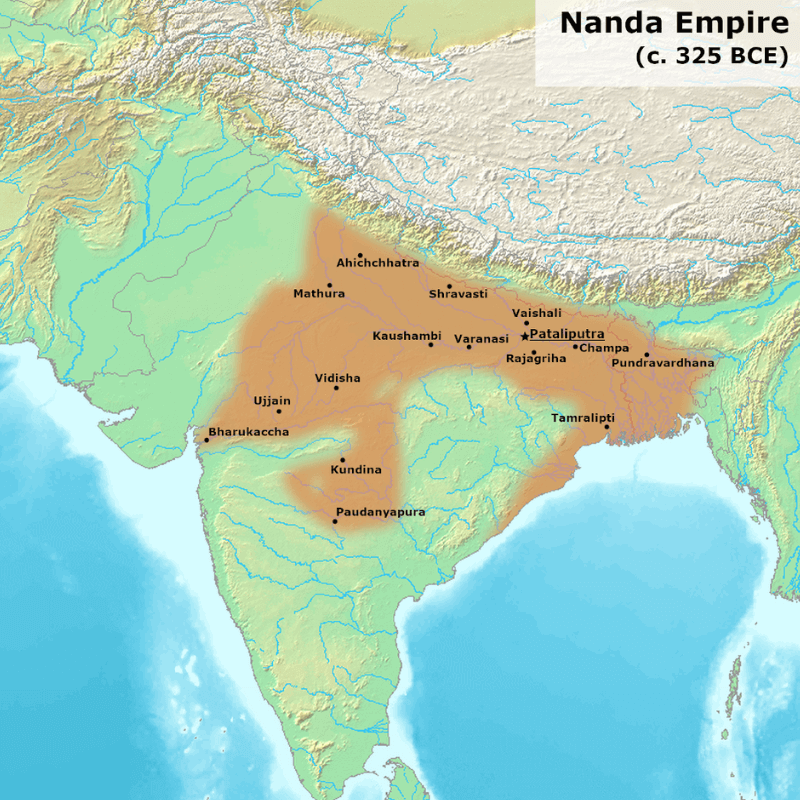
There were several powerful dynasties of Magadha with control over a significant part of northern India at different times. Magadha was one of the 16 Mahajanapadas and was fought over for its fertile plains and seat of power in Ancient India. Read here to learn more.
The Magadha Kingdom was an ancient Indian kingdom located in the northeastern part of the Indian subcontinent. It played a pivotal role in the early history of India and was instrumental in the rise of several major empires and religious movements.
Magadha’s history dates back to the Vedic period (around 1500-500 BCE). It was one of the sixteen Mahajanapadas (great kingdoms) mentioned in ancient Indian texts.
Magadha was a significant region throughout ancient and medieval Indian history, with various dynasties ruling it at different times.
Dynasties of Magadha
Magadha, an ancient region in the eastern part of the Indian subcontinent, was the seat of several powerful dynasties and played a crucial role in the political and cultural history of India.
The first or earliest ruling dynasty of Magadha was the Brihadratha dynasty founded by Brihadratha. The name is mentioned in the Rigveda and Mahabharata as well.
The Brihadratha dynasty is not as well-documented or well-known as some other dynasties in ancient Indian history.
- According to Puranas Brihadratha was the eldest of the five sons of Uparichara Vasu, the Kuru king of Chedi and his queen was Girika.
- It is said that he had a son named Jarasandha, who played a significant role in the Mahabharata, one of the major ancient Indian epics.
- Jarasandha, according to the Mahabharata, was a powerful king of Magadha and a staunch adversary of the Pandava brothers. He was eventually defeated and killed by Bhima, one of the Pandavas.
It’s important to note that the details about the Brihadratha dynasty are somewhat shrouded in myth and legend, and the historical accuracy of some accounts is debated among scholars. Due to the lack of extensive historical records, many aspects of this dynasty remain unclear.
Haryanka Dynasty (6th century BCE)

The Haryanka dynasty is believed to be the earliest ruling dynasty of Magadha. King Bimbisara is the most famous ruler of this dynasty. He was a contemporary of Gautama Buddha and was an early patron of Buddhism. His son, Ajatashatru, succeeded him and continued the dynasty’s rule.
The Haryanka dynasty is believed to have been founded by Bimbisara, who was the son of King Bhattiya.
Bimbisara
- Bimbisara is credited with expanding the Magadha kingdom’s territories through both diplomacy and military campaigns.
- He is known for his friendly relations with Gautama Buddha and for becoming a patron of Buddhism.
- Bimbisara’s reign marked the beginning of the Magadha region’s prominence in North India.
Ajatashatru
- Bimbisara’s son, Ajatashatru, succeeded him as the ruler of Magadha. Ajatashatru is known for his military conquests and the fortification of the capital city, Rajagriha (modern Rajgir).
- He also played a role in the early development of Buddhism.
Udayin
After Ajatashatru, the Haryanka dynasty continued with Udayin, who shifted the capital from Rajagriha to Pataliputra (modern Patna). This move was significant in the context of Magadha’s political and administrative history.
End of the Dynasty
The Haryanka dynasty came to an end with the assassination of Udayin. It marked the beginning of the Shishunaga dynasty’s rule in Magadha.
The Haryanka dynasty’s rule marked a critical phase in the history of Magadha and the Indian subcontinent. It laid the foundation for the emergence of the powerful Maurya Empire, as Bimbisara’s son, Ajatashatru, was succeeded by his son, Chandragupta Maurya. Chandragupta Maurya went on to establish one of the first major empires in India.
The Haryanka dynasty’s significance lies in its role as a precursor to the larger political developments that would shape ancient India. It set the stage for the rise of Magadha as a dominant power in the region and the eventual establishment of the Maurya Empire, which played a crucial role in early Indian history.
Shishunaga Dynasty (5th century BCE)
The Shishunaga dynasty succeeded the Haryanka dynasty. Shishunaga is said to have overthrown the last Haryanka ruler, Nagadashaka. During this period, the Magadhan capital shifted from Rajagriha to Vaishali. This dynasty paved the way for the rise of the Nanda dynasty.
The founder of the Shishunaga dynasty was Shishunaga himself. He is believed to have usurped the throne of Magadha, which was previously under the control of the Haryanka dynasty.
- The Shaishunaga dynasty ruled one of the largest empires in the Indian subcontinent. A most crucial achievement of Shishunaga was the destruction of the Pradyota dynasty of Avanti.
- This brought to an end the hundred-year-old rivalry between Magadh and Avanti. From then Avanti became a part of Magadh.
Kalashoka
- The two most significant events of his reign are the Second Buddhist Council at Vaishali in 383 BCE and the final transfer of the capital to Pataliputra
The Shishunaga dynasty marked the transition from the Haryanka dynasty to the more prominent Nanda dynasty, which, in turn, paved the way for the emergence of the Maurya Empire under Chandragupta Maurya.
Nanda Dynasty (4th century BCE)

The Nanda dynasty, founded by Mahapadma Nanda, was the first to establish a large empire in northern India. However, they are often portrayed negatively in ancient Indian texts, including the Mahabharata, for their tyranny.
The Nandas were eventually overthrown by Chandragupta Maurya, marking the rise of the Mauryan Empire.
The Nanda dynasty was founded by Mahapadma Nanda. He is said to have established the dynasty by overthrowing the last ruler of the Shishunaga dynasty, which ruled Magadha before the Nandas.
- The Buddhist, Jain, and Puranic traditions all state that there were 9 Nanda kings, but the sources differ considerably on the names of these kings.
- He was followed by his eight sons, with Dhana Nanda being the most prominent among them.
- Dhana Nanda is known for his wealth and luxury, but his reign also faced significant challenges, particularly from the rise of Chandragupta Maurya.
- Dhana Nanda’s military strength is said to have intimidated Alexander’s army who had reached the Beas River. Alexander’s men mutinied when faced with the prospect of facing the Nanda army, forcing Alexander to withdraw from India.
The Nanda dynasty’s most significant historical event was its confrontation with Chandragupta Maurya, who founded the Maurya Empire. Chanakya, also known as Kautilya or Vishnugupta, a prominent ancient Indian scholar and strategist, played a crucial role in Chandragupta Maurya’s rise to power.
Chandragupta Maurya and Chanakya’s strategies and military campaigns ultimately led to the downfall of the Nanda dynasty around 322 BCE.
Mauryan Empire (4th – 2nd century BCE)
Although the Mauryan Empire extended well beyond the boundaries of Magadha, it had its origins in this region. Chandragupta Maurya established the empire, with Pataliputra (modern-day Patna) as its capital. Under the rule of Ashoka, the Great, the Mauryan Empire reached its zenith and played a significant role in the spread of Buddhism.
Shunga Dynasty (2nd – 1st century BCE)
After the decline of the Mauryan Empire, the Shunga dynasty, founded by Pushyamitra Shunga, ruled over Magadha and other parts of northern India. This period saw a revival of Hinduism after the patronage of Buddhism during the Mauryan era.
The Shunga dynasty was founded by Pushyamitra Shunga, who was the commander-in-chief of the last Mauryan ruler, Brihadratha. Pushyamitra Shunga is believed to have assassinated Brihadratha and established his rule, marking the end of the Mauryan dynasty.
- The Shunga dynasty’s capital was initially at Pataliputra (modern-day Patna), but it later shifted to Vidisha and then to Ayodhya.
- The Shungas were Brahmins, and they sought to restore Brahmanical Hinduism’s prominence in India. They are known for their patronage of Brahmanical rituals and institutions, which saw a revival during their rule.
- The Shunga dynasty’s rise marked a period of decline for Buddhism in India, as Pushyamitra Shunga and some of his successors are believed to have been hostile to Buddhism.
- During the Shunga period, India faced threats from foreign invaders, particularly the Indo-Greeks. The Shunga rulers had to deal with these incursions, and the conflict with the Indo-Greeks in particular is well-documented.
The Shunga dynasty eventually declined, and its rule ended around 73 BCE when it was overthrown by the Kanvas, another dynasty in North India.
Kanva Dynasty (1st century BCE)
The Kanva dynasty followed the Shungas, but it had a relatively short and less significant rule. They ruled from Pataliputra but were eventually overthrown by the rise of the Satavahana dynasty in the Deccan.
The Kanva dynasty was founded by Vasudeva Kanva, who overthrew the last Shunga king, Devabhuti, in around 73 BCE. This event marked the end of the Shunga dynasty’s rule.
- Vasudeva Kanva was followed by his successors, Bhumimitra, Narayana, and Susharman, although not much is known about their reigns or accomplishments.
- The Kanva rulers were known for their patronage of Buddhism. During their reign, Buddhist monastic institutions received support, and Buddhism continued to thrive in the region.
The Kanva dynasty came to an end in 28 BCE when it was overthrown by the Satavahana king Satakarni. This marked the beginning of the Satavahana dynasty’s rule in parts of northern India.
Gupta Empire (4th – 6th century CE)
Although not originally from Magadha, the Gupta dynasty, which had its origins in the neighboring region of Magadha, played a crucial role in Indian history. Pataliputra served as one of its prominent capitals. The rise Gupta Empire took away the central importance of the Magadha region eventually.
Later in 750 CE, the Pala Empire of Bengal also ruled over Magadha and maintained a royal camp in Pataliputra.
These are some of the major dynasties of Magadha and contributed to the rich tapestry of India’s historical and cultural heritage.
Decline of dynasties of Magadha
The Magadha region saw frequent changes in rulers and dynasties, leading to political instability.
- After the Mauryan Empire, several more minor dynasties like the Sungas, Kanvas, and Indo-Greeks briefly controlled the area. This lack of stable governance weakened the region’s overall strength.
- Foreign invasions of the Indo-Greek and later the Indo-Scythian rulers held sway over parts of Magadha, which disrupted local governance and cultural stability.
Magadha’s decline can also be attributed to the fragmentation of the empire. The Mauryan Empire, which was at its zenith under Ashoka, eventually disintegrated into smaller regional kingdoms.
- These smaller states lacked the central authority and resources to maintain the level of influence that the Mauryan Empire had enjoyed.
The decline of Buddhism in India, which had strong roots in Magadha, played a role in the region’s decline. As Buddhism waned, Hinduism gained prominence, and major centers of learning and religious activities shifted to other parts of India.
Geopolitical changes, such as the rise of other powerful Indian kingdoms and foreign invasions, altered the balance of power in the subcontinent. The rise of the Gupta Empire in northern India marked a shift in emphasis away from Magadha.
Changes in trade routes and economic activity also affected Magadha’s prosperity. The Silk Road and other trade routes shifted, diverting commerce away from the Magadha region. Economic decline contributed to the weakening of the state.
It’s important to note that the decline of Magadha was a gradual process that occurred over centuries, and multiple interconnected factors contributed to it.
Despite its decline as a political and cultural center, Magadha’s historical significance remains, as it played a crucial role in shaping the history and culture of ancient India.
-Article by Swathi Satish






In Haryanka Dynasty it says, Ajatshatru was succeeded by his son Chandragupta maurya.. please correct this..